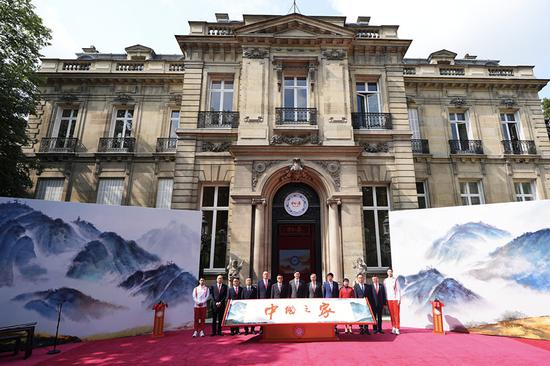
Parts of the SKA radio telescope are loaded on a truck in Shijiazhuang, Hebei province, on Wednesday, to be transported to Tianjin and then onward to South Africa. (Photo provided to China Daily)
The first middle-frequency dishes of the Square Kilometer Array radio telescope, the world's biggest astronomy observation network and an international mega-science project, have begun to be transported to their destination in South Africa.
At a ceremony on Wednesday morning in a northwestern suburb of Shijiazhuang, the capital of Hebei province, experts announced that the first batch of four Square Kilometer Array middle-frequency dishes — SKA-Mid for short — had passed quality examination and were being transported by heavy-lift trucks to a cargo port in Tianjin, where they will be put on a ship to South Africa.
The Square Kilometer Array is an ambitious scientific endeavor involving several nations including China, the United Kingdom and Australia. It is not a single radio telescope, but a collection of various types of antennae called an array, and is spread over long distances with up to 1 square kilometer in total collecting surface area, the equivalent of 140 soccer fields.
The project is managed by the SKA Observatory, an intergovernmental organization based in Manchester in the UK.
China is responsible for the research and development of the SKA-Mid dishes as well as the production for the first 64 such instruments.
Most of the parts for the large parabolic dishes, including the main reflectors, servo devices and support arms, were designed and built by the Shijiazhuang-based 54th Research Institute of China Electronics Technology Group Corp, which is the major Chinese contractor in the SKA project.
Yin Qiuhua, deputy project manager for SKA-Mid, said the first four dishes are scheduled to arrive in South Africa in the coming months and then be installed in the Karoo region.
"After they arrive at their destination, Chinese engineers will work with local workers to assemble and fine-tune them," he said after the ceremony.
Delivery of the 64 SKA-Mid dishes is expected to be finished before the end of 2026, and all of them will be mounted in the Karoo region, Yin said.
The operation of SKA-Mid requires extremely high accuracy in terms of beam deformation, pointing precision, electromagnetic shielding and electromagnetic compatibility, according to Du Biao, chief designer of the dish at the institute.
"Its design and production are very challenging for us," he said. "To solve these demanding technical issues, our researchers and engineers made all-out efforts to develop world-class technologies for its servo systems, dynamic simulation, and calibration and testing methods."
Another major section of the SKA project, the low-frequency antennas, or SKA-Low, will be located in the remote Murchison area in Western Australia.
Eight other African nations, including Botswana, Ghana and Kenya, will also house some of the mega-science mission's facilities.
All of the sites have been chosen for scientific and technical reasons, including radio quietness.
Upon its scheduled completion in the coming decade, SKA will be the largest and most advanced astronomy system on Earth and is expected to provide an unprecedentedly detailed insight into the history of the universe. It will also enable scientists to better understand the nature of gravity, explore the origins of life and cosmic magnetic fields, and search for extraterrestrial life.
The super network's ultra-large collecting area will give it 50 times the sensitivity and 10,000 times the survey speed of the current best — the Karl G. Jansky Very Large Array in New Mexico in the United States.
The full array will produce data at a rate more than 100 times that of global internet traffic, according to Chinese scientists involved in the program. They said the system will be so sensitive that, metaphorically speaking, it will be able to pick up conversations from an aircraft 50 light-years away.
It is China's second-largest international science collaboration after the International Thermonuclear Experimental Reactor, the world's largest nuclear fusion experiment.

















































 京公网安备 11010202009201号
京公网安备 11010202009201号